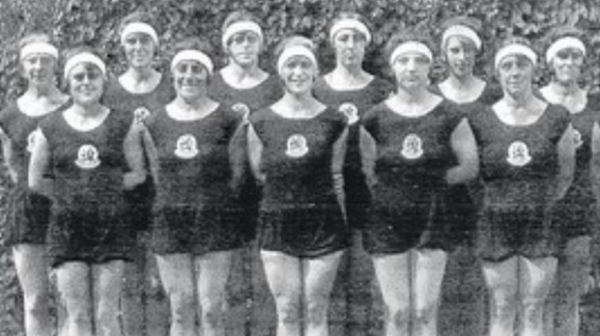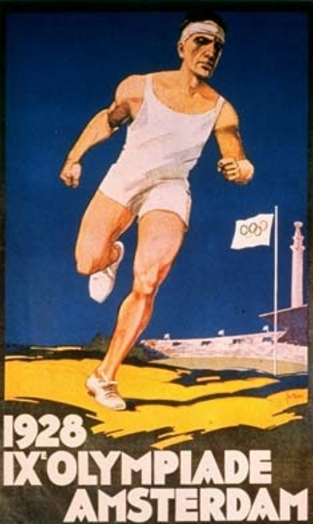
The team gold medal is arguably the most coveted of awards in women’s artistic gymnastics — while all-around gold is a gymnast’s dream, when we ask who won that year we are usually referring to a country, and when Martha Karolyi’s decisions are questioned, we can usually find that they are justified for the sake of the team. Thus, fans might find it strange that they, in all likelihood, would not be able to name which country earned this title at the very first Olympics in which women were invited to compete in gymnastics.
The ninth modern Olympics, held in Amsterdam in the summer of 1928, was an Olympics with several firsts: it was the first Olympics to feature a torch, though there was no relay; it was the first Olympics held within what has become the standard 16-day schedule; and, while it was not the first Olympics where women were allowed to compete (that was Paris in 1900), it was the first time women were allowed to compete in athletics and gymnastics.
This may have been due to the absence of the International Olympic Committee’s founder and second president, Pierre de Frédy, Baron de Coubertin, who is largely credited with beginning what is known as the modern Olympic movement. Coubertin was staunchly against women participating in sports, so it may be no coincidence that women were only allowed to compete in athletics and gymnastics after his departure in 1925, and that the number of women competing in the 1928 Olympics more than doubled the number competing at the Paris Games in 1924.
The format of the gymnastics competition, however, was very different from what we see today. While the men had nearly the same number of events — a team final, an all-around final, and an individual final for every apparatus except floor — the women only competed in a team final. There were 60 women in total competing, and they formed five teams of twelve each. Ten of the twelve gymnasts on each team competed in three events, known as Drill, Apparatuses, and Jumps, and scores on each were combined for a total team score.

It is unclear what was actually involved in these events; one photograph from the competition shows French women rope climbing, and one account notes that the women competed on wall bars. The jumps were apparently vaults, and the only videos that are available from the event show women doing synchronized exercises in the Olympic stadium in what now looks like a group stretching session. Videos from the 1936 Olympics show women participating on vault, uneven bars, beam, and parallel bars, though it is unclear if these were the same events used in 1928.
What is clear, though, is that the results of the competition were heavily in favor of the home team. The Netherlands won the team final with 316.75 points, beating Italy on all events. Italy came in second with a 289.00, and Great Britain came in third with a 258.25. Hungary and France came in fourth and fifth, respectively. It seems ironic considering how the sport would evolve toward being dominated by younger women, but Carla Marangoni, a member of the Italian team that year, would attribute the Dutch win to their age and experience: “They were older and had muscles. They were women and we were girls,” she said in a 2012 interview.
Marangoni, who turned 100 in November of this year and says she still exercises, but claims that she has misplaced her silver medal somewhere, was only 12 when she competed at the 1928 Olympics, but she was not even the youngest member of her team: the youngest was Luigina Giavotti, who was 11. The oldest member of the Italian team was 17, and the average age for the team was 14. In contrast, the women on the Dutch team ranged from 19 to 31 years old, with an average age of 23. Giavotti remains the youngest medalist in Olympic gymnastics history, and her record cannot be beaten with the current age restrictions.
Most of the women on the Dutch and Italian teams seem to have lived long lives, but the exceptions to the rule are a grim reminder of the horrors of the time in which they lived. Bianca Ambrosetti, a fourteen-year-old who competed for Italy, was sick with tuberculosis during the Olympics, and died the next year. In addition, five of the members of the Dutch team, along with their coach, were Jewish, and only one of those six would survive the Holocaust. Jud Simons, Anna Dresden-Polak, Helena Nordheim, and their coach Gerrit Kleerekoper died at the Sobibor concentration camp, and Estella Agsteribbe was killed at Auschwitz. Only Elka de Levie managed to evade the camps, and she died at age 74 in Amsterdam.
Not much else is known about these women, but they did leave a strong legacy as, if anything, the first. They were the pioneers of the women’s side of what would become one of the most popular sports of the Olympics, and one that, at this point, has a strong legacy in the world of sport. The video of these women performing might seem trite, even laughable, compared to what female gymnasts do at the Olympics in the modern day, and even what you might be able to do in your living room, and it is a strong reminder that the sport is ever-evolving and not easily defined. What has remained constant, however, are the principles that made the Dutch women the greatest at the first Olympics: their demonstration of grace, strength, balance, and teamwork.
Article by Jessica Taylor Price



So interesting! Thank you for all your hard work!!
LikeLiked by 1 person
Wow!… thanks for the piece. I just wish we know more about what their routines and preparation were like…..think you can somehow contact Marangoni and do an interview? 🙂
LikeLike
That was so interesting thanks! Would love some more historical pieces in the run up to Rio if you can!
LikeLike
I love you evermore for this articleeeeee!!
LikeLike
This is a fantastic article! I’m always eager to learn more about gymnastics history! Thanks especially for the links – I’d seen the video before, but the Carla Marangoni interview was brand new to me. Here’s hoping for more articles like this in the future!
LikeLike
Pingback: Only 4 Latina Gymnasts Have Repped Team USA at the Olympics Since 1936 « NewsTaco
Nice article, but with some small mistakes. Amsterdam 1928 was the 9th Olympiad, not the 9th Olympic Games. The 1916 Games were cancelled, but not the 1916 Olympiad. So, Amsterdam was the 8th Olympic Games which took part during the 9th Olympiad.
The video you mentioned is not the olympic final, but the exhibition exercices. No prices werd awarded, the teams were open to at least 16 men and/or 16 women, with no maximum. There is also a video of the final: http://www.npogeschiedenis.nl/speler.WO_VPRO_042631.html
About the Dutch team a book was written in 2009: Spartacus – Erik Brouwer. Brouwer wants to make a new book about this team.
LikeLike